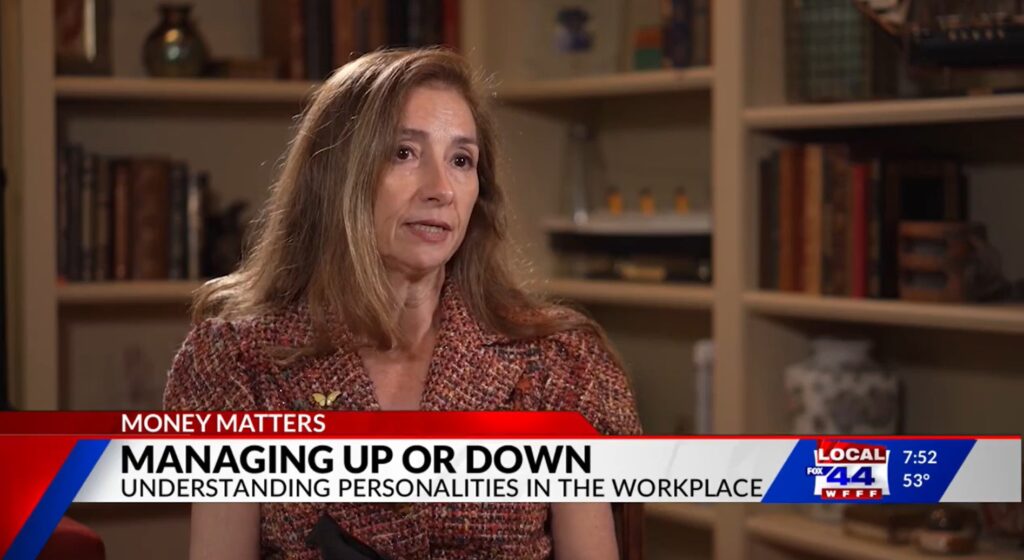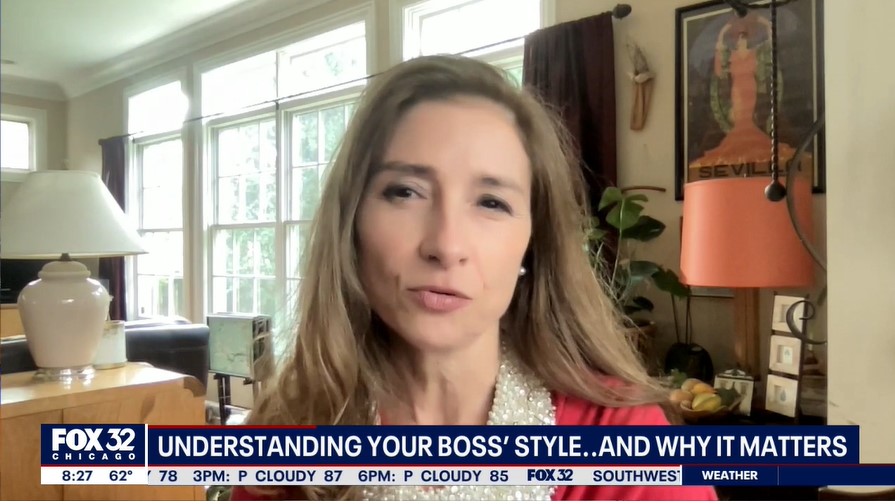I recently had the pleasure to introduce the Characters to several news stations. Take a peek…
WFFF Fox44 Burlington, VT

KSAT12 ABC St. Louis

News4 JAX

WAFB 9 Baton Rogue

I recently had the pleasure to introduce the Characters to several news stations. Take a peek…





Showing your emotions at work used to be considered taboo; crying for women at work could be a career killer. Jennifer joins Molly Fay on The Morning Blend to talk about how this sentiment may be changing with the remote work/hybrid work environment we now find ourselves in and how the benefits of Emotional Intelligence EQ have been increasingly highlighted as valuable for managers to have.
Jennifer joins Dr. Vince Molinaro on Lead the Future to discuss how senior leaders can prepare for human capital challenges when undergoing a merger or acquisition, as well as how leaders themselves can navigate the changing and often ambiguous environment that arises post M&A.
Jennifer joined Molly Fay on The Morning Blend this month to talk about leadership personalities and how to have success at work no matter what style of boss you work for.
The Recent studies show that 75% of people who quit their jobs are actually quitting their boss. Understanding your boss’ style and how to work with it will set you up for success. It could mean the difference between thriving or diving at work.
Uncertainty is not to be avoided and it’s not to be tolerated. According to Jennifer Fondrevay, we need to wholeheartedly embrace uncertainty and redirect our focus to the things we can control, our Talent, Effort, and Attitude. By embracing uncertainty, we will create our own opportunities and discover a fulfilling career and life.
This talk was given at a TEDx event using the TED conference format but independently organized by a local community. Learn more at https://www.ted.com/tedx



I spoke with Fox 32 Chicago to break down several less-than-effective leadership styles and how employees can best mesh inside the workplace.

Jennifer joined John Baldoni on LinkedIn Live for GRACE under Pressure, where he interviews thought leaders and doers whose ideas and actions are helping us come to a greater understanding of ourselves and the greater opportunities that await us.
You can listen to this podcast on YouTube, Spotify or Apple Podcasts.
In this Work Arts interview, Brandon Curry and Jennifer J. Fondrevay discuss their individual experiences leading and advising organizations through mergers, acquisitions, and other significant transformations. Jennifer shares how calls for help have changed, including her perspective on lessons leaders have learned from leading through the pandemic that help us lead through transactions and transformations. Brandon and Jennifer also discuss how post-merger integration culture and team development work is different following nearly two years of hybrid and remote work.
Watch this Facebook live interview with Ellen Rogin of horsesmouth.com!
by Firmex
This interview features “M&A whisperer” Jennifer J. Fondrevay, discussing best practices for managing the human element of M&A and Touchpoint.
Closing a merger or acquisition is one thing, but successfully integrating the two companies post-M&A brings complex challenges, not least of which is getting the workforce on board so that the value of the merger can be realized. We sat down with Jennifer J. Fondrevay, organizational transformation consultant and “M&A whisperer” to discuss best practices for managing the human element of M&A.
Jennifer J. Fondrevay is an organizational transformation guru and the founder of Day1 Ready™, an M&A consultancy that works with Fortune 500 companies, start-ups, and small businesses to keep their growth strategies on track. Serving as an advisor to senior leadership and a liaison to middle managers, Fondrevay ensures the human component of a company’s plan, such as culture, productivity, and retention remains a cornerstone of success during times of change. Having been on all sides of the M&A equation, Jennifer sheds light on navigating a rapidly changing work environment through her speaking engagements and soon to be published book NOW WHAT? A survivor’s guide for navigating and thriving through acquisition.
TOUCHPOINT: You’ve written about “the secret language of mergers and acquisitions” where executives say one thing and employees hear something else entirely. How can business leaders make sure they’re speaking the same language as their workforce post-M&A?
JF: There are three things a business leader needs to keep in mind when sharing news post deal:
Expect that the majority of the workforce already knows something is going on. Do not assume people are clueless. They may not have all of the details correct but they will be aware that something has been in the works. The first mistake leaders can make is to believe that people have not been paying attention to what is going on. In speaking to your workforce, treat them with respect in how you share the news.
Do not use clichéd, “jargony” marketing language to sell the vision and persuade the workforce that this is a great thing. It makes the message less believable. People are not oblivious to the fact that big size M&A deals have typically failed (consider: AOL/Time Warner; HP/Palm; Alcatel/Lucent; Quaker/Snapple) and all the words that have been imprinted in people’s brains around these failed acquisitions are jargony, marketing words.
Be transparent as much as you can be. Respect your workforce’s desire to know the truth. Connect the vision of the acquisition to the work that you are doing and where you are going. Tell your people openly how the vision came to be and how the acquisition contributes to that future (whether you were acquired or acquired another). They need to hear from your heart why this is such a good thing. If you speak from a place of honesty and passion and purpose, people will begin to hear your message.
TP: What are some of the most overused and clichéd phrases that executives use to “sell” a merger or acquisition to employees?
JF: “Nothing is changing” is the #1 most overused phrase. The reality is everything has already changed.
“You will have better benefits, more resources, and greater opportunities”
“This is a merger of equals”
“This allows us to transform our business.”
“We expect minimum reductions in staff.”
I do believe that the phrases are well-intentioned, meaning that the messenger believes the message to be true. Unfortunately, they have become so cliché that people simply don’t buy it. Additionally, people are naturally thinking about themselves, not the company, when they first hear the news. So what they hear is often “blah, blah, blah…” because they are focused on themselves. The best analogy I’ve used is the Gary Larson cartoon – “What we say to dogs, what they hear”:

If I were to replay the above Gary Larson cartoon scene through the lens of M&A, here is what Ginger (ostensibly our workforce – go with me here) would hear from the executives:
What Executives say to the workforce: We are very excited to share with you that XYZ companies have been acquired by ABC company. This means great opportunities for us all. You will have enhanced benefits and be out in the marketplace with a greater portfolio, enjoying expanded aspects of your job.
What the Workforce hears: We/ are very excited to share with you that XYZ companies have been acquired by ABC company. This means great opportunities for us all. You will have expanded benefits and be out in the marketplace with a greater portfolio enjoying expanded aspects of your job.
The workforce can’t hear what’s being said because their primary focus is “What happens to my job?” If messaging leaves that unclear for too long and how you sell it seems disingenuous, significant parts of your workforce can have a hard time getting behind the vision. They will stay in denial.
TP: What’s the biggest reason mergers and acquisitions fail to deliver value after the M&A deal is done?
JF: To uncover the consistent challenges of M&A, I interviewed 65 executives from multinational to small- to medium-size companies all over the world. The interviewees included C-suite executives, private equity dealmakers, business owners, entrepreneurs, and middle managers.
From these sessions, there were 4 reasons consistently cited:
TP: What’s the most common blunder that organizations make following an M&A transaction?
JF: Although people are critical contributors to the upfront business valuation and post-deal integration success, leaders more often delay the people planning piece. Not doing the people pre-planning on the frontend can doom success on the backend. Earlier I cited “unexpected people problems” as one of the reasons consistently cited for M&A failures. I always challenge that. They aren’t unexpected. You can expect them; by preparing for them on the frontend you can minimize the challenges. In my Day1 Ready™ approach, I focus executives on three key areas to prepare for people challenges:
TP: The people who put M&A deals together – entrepreneurs, owners, CEOs, CFOs, investment bankers and M&A advisors – are experts at analyzing balance sheets and growth strategies. In your experience, do they struggle with the human element of M&A, and, if so, what is the impact?
JF: It’s not that the people who put the deals together struggle with the human element – it is simply not their focus. If you think about it, no one ‘wants’ the post-merger effort to be unsuccessful. It’s an unfortunate aspect of being too short-sighted and ONLY considering the numbers. I get that – most of the advisors’ expertise is in evaluating businesses, running the financials, forecasting growth potential, etc.
I would suspect that private transactions have a higher percentage rate of ‘success’ because they don’t have to answer to Wall Street in 90 days and speak to the “actual results.” Equally, I see Family Offices enjoying strong success rates and I expect that is due to their more patient approach on results and a focus on values/human capital.
There are millions of dollars our there ready to invest – in order to make these deals happen and to be successful, dealmakers need to think differently about their positioning going into the deal and the metrics for success of that deal. My position is, they need to more consistently and proactively bring in that human capital advisor role so that they can better anticipate what the people challenges will be and how to prepare for them. Future deal success is what is at stake for dealmakers.
TP: Investment bankers and advisors are focused on finding the right buyer and closing the deal. What, if any, role do they have in post-merger transformation?
JF: The tough part is, Investment Bankers (IB) are not usually compensated for work post-merger. For those who do, it’s largely ‘goodwill’, if you will. The IB’s ability to have an influence on the post-merger transformation is limited by what the client and/or acquirer allow the investment banker to do and whether the client is staying in the business or exiting. I have seen Investment Bankers be most successful by proactively defining their role beyond just putting the deal together. They invest time upfront beyond the numbers to set the business up for success.
One of the values of running a process is to help the client engage with multiple parties to get a ‘feel’ for how their culture would fit with potential acquirers. Once the ideal acquirer is designated, successful IBs begin shepherding those human relationships while the other ‘deal-centric’ tasks get completed. Smart IBs also tap into a wide variety of service providers who bring unique areas of expertise that help make the deal successful. Given the time they have typically spent with the client, these investment bankers know which advisors to pull in when. When an IB can play a role post-merger, there is a better chance for success on the backend, and the advisor is more likely to become known for putting together successful deals.
TP: I’d like to believe that most business owners care about their employees. When negotiating an M&A deal, what can owners and their advisors do to ensure that the best interests of employees aren’t treated as an afterthought?
JF: In today’s market, with all that capital out there to invest, owners who are selling have the power. They can drive the conversation to ensure that their employees are not treated as an afterthought. Obviously, they need to be realistic about the expectations and the demands they make but they need to make the people piece a key part of the discussion upfront and gain agreement in writing around those expectations. They can’t just hope it will be taken care of. The moment they sell the business they are no longer in charge. I have seen well-intentioned owners think they have agreements that dissolve once the business changes hands. I also know other owners who made the expectations an essential part of the deal and prevailed. I want to emphasize, however, that the expectations have to be reasonable. It is unrealistic to expect that every employee can continue to play the same role once acquired by another company or a PE firm. The expectations need to be reasonable and agreed to.
I counsel business owners to make sure they talk to a human capital advisor the moment they start thinking about selling, especially if they don’t have a human resources executive on their staff. Typically, owners talk to their lawyer or accountant. These roles focus on the financials and legalities of the transaction. You need someone who can advise you on the people piece. It’s why I am jokingly referred to as the “M&A Whisperer” as I like to advise business owners on what to expect and how to best manage the people side in-going.